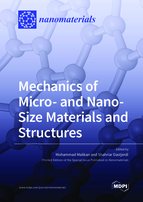Mechanics of Micro- and Nano-Size Materials and Structures
A special issue of Nanomaterials (ISSN 2079-4991).
Deadline for manuscript submissions: closed (30 June 2022) | Viewed by 21309
Special Issue Editors
Interests: plates and shells theory; viscoelasticity; FGMs; composite structures; size-dependent theories; smart composites; nanocomposites; molecular dynamics; electro-mechanical structures
Special Issues, Collections and Topics in MDPI journals
Interests: micro/nanomechanics; plates and shells theory; mechanical behavior of carbon nanostructures (fullerene, single- and multi-layered graphene particles); viscoelasticity; three-dimensional elasticity analysis; numerical and semi-analytical solution methods; atomic force microscope; crack analysis; FGMs; composite structures
Special Issues, Collections and Topics in MDPI journals
Special Issue Information
Dear Colleagues,
Nanotechnology knowledge is always looking to expand its boundaries to achieve the greatest benefit to human life and meet the growing needs of today. In this case, we can refer to nanosensors. These electrical devices are capable of detecting very small physical stimuli up to one nanometer in size. Today, micro/nanosensors devices are widely used in the environment. For example, sensors made of silicon are suspended in the air for hours and can monitor air pollution. Therefore, the prediction of the mechanical response of such small size particles in different physical and environmental conditions is momentous. To obtain this, micro and nano-mechanics enable the scientific basis of the structural response of micro/nanostructures based on different situations.
For this Special Issue, we intend to cover theoretical as well as experimental works performed on small scale to predict the material behavior of any metamaterials. These structures can be investigated computationally through several theories such as multiscale modelling, size-dependent continuum approaches, etc. and also computer simulations such as molecular dynamics. New studies on mechanics of all small scale structures such as MEMS/NEMS, carbon and non-carbon nanotubes (e.g., CNTs, Carbon nitride, and Boron nitride nanotubes), micro/nano-sensors, nanocomposites, macro composites reinforced by micro-/nano-fillers (e.g., graphene platelets), etc. are also included in this Special Issue.
Dr. Mohammad Malikan
Dr. Shahriar Dastjerdi
Guest Editors
Manuscript Submission Information
Manuscripts should be submitted online at www.mdpi.com by registering and logging in to this website. Once you are registered, click here to go to the submission form. Manuscripts can be submitted until the deadline. All submissions that pass pre-check are peer-reviewed. Accepted papers will be published continuously in the journal (as soon as accepted) and will be listed together on the special issue website. Research articles, review articles as well as short communications are invited. For planned papers, a title and short abstract (about 100 words) can be sent to the Editorial Office for announcement on this website.
Submitted manuscripts should not have been published previously, nor be under consideration for publication elsewhere (except conference proceedings papers). All manuscripts are thoroughly refereed through a single-blind peer-review process. A guide for authors and other relevant information for submission of manuscripts is available on the Instructions for Authors page. Nanomaterials is an international peer-reviewed open access semimonthly journal published by MDPI.
Please visit the Instructions for Authors page before submitting a manuscript. The Article Processing Charge (APC) for publication in this open access journal is 2900 CHF (Swiss Francs). Submitted papers should be well formatted and use good English. Authors may use MDPI's English editing service prior to publication or during author revisions.
Keywords
- Micro/Nano-scale theories
- Micro/Nano FGMs
- Micro/Nanocomposites
- Micro/Nano-electro-mechanical particles
- Multiscale models
- Micro/Nano-wires
- Carbon and non-carbon nanotubes
- Atomic force microscope







